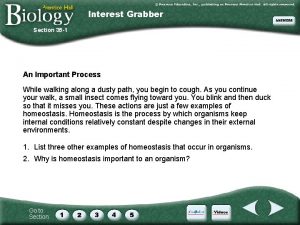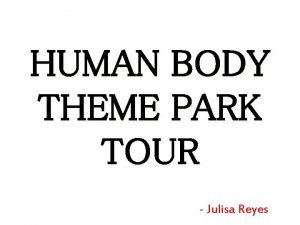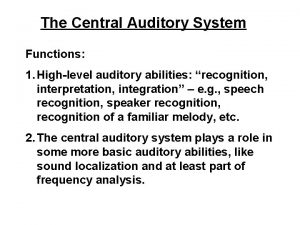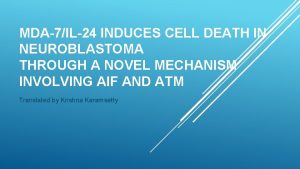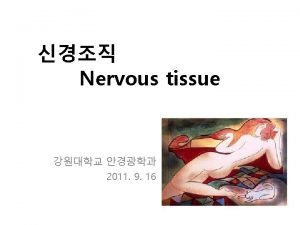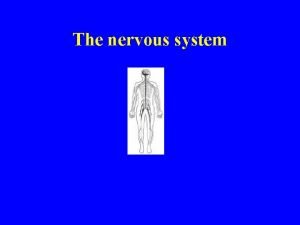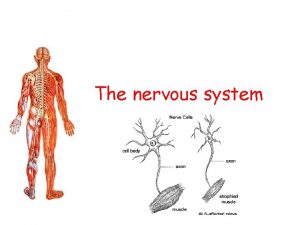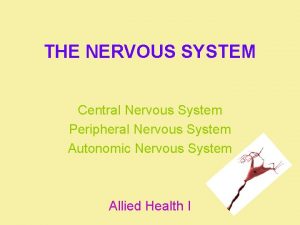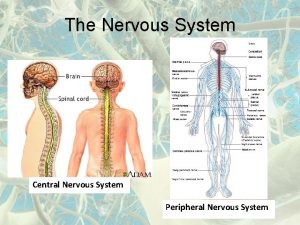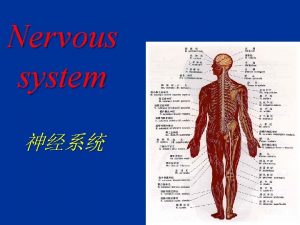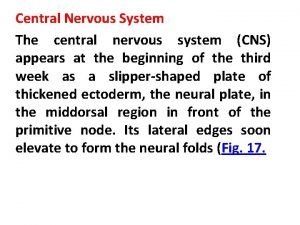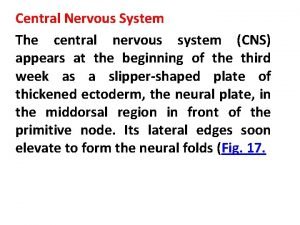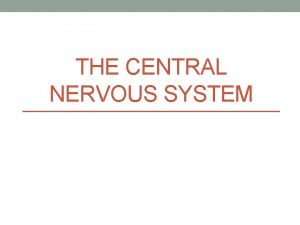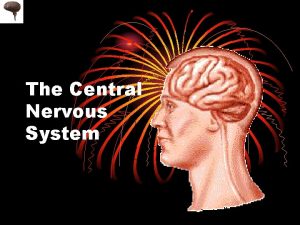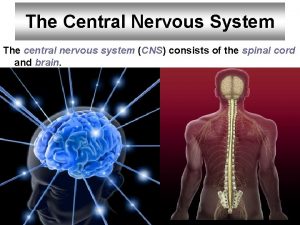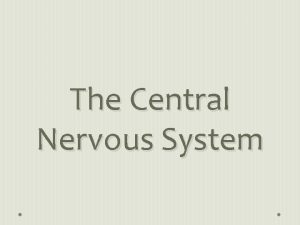Central Nervous System Drugs Nervous system Central nervous






















- Slides: 22

Central Nervous System Drugs

Nervous system Central nervous system Brain Spinal Cord Peripheral nervous system Somatic NS , innervates skeletal muscles Autonomic nervous system (ANS) Sympathetic nervous system Parasympathetic nervous system

Introduction The effect of drugs on the central nervous system (CNS) Drugs produce their effect on the body through two major processes. The first is the effect of the chemical properties of the drug on the central nervous system (CNS) which includes the brain and the spinal cord. This process is called pharmacodynamics. The second is how the drugs enter, are metabolized, and absorbed by the body. This process is known as pharmacokinetics. These two processes work together to produce a certain effect.

Introduction A psycho-active drug must find its way to the bloodstream to have an effect on the brain. Once the drug reaches the brain, it can lodge on to specific receptor sites on the neurons which are sensitive to particular types of drugs. Each drug affects specific neurons in a number of parts of the brain. There are 13 billion neurons or nerve cells in each person's brain. This called Neurotransmitters.

Introduction Many drugs seem to imitate neurotransmitters, the natural chemicals that facilitate or inhibit the transfer of electrical impulses between neurons. For example, opiate drugs such as heroin are thought to exert their drug action by mimic endorphins which are naturally occurring proteins that reduce pain. Drug action Drugs can act like neurotransmitters, drugs can speed up (CNS stimulants) or slow down (CNS depressants) the transfer of electro-chemical messages between neurons in the brain.

Introduction Messages between neurons can also be distorted when hallucinogenic drugs are taken. Drugs appear to act directly on 'pleasure centers' in the brain, which may explain the euphoria experienced by users of many different types of drugs. It is believed that the effect on the pleasure center is highly rewarding for many young people. (drugs)

Drugs affect CNS These Drugs can alter the function of the central nervous system to provide : Anticonvulsant effect Tranquilization (sedation ) Analgesia(pain relive ) Examples for neurotransmitter in CNS Dopamine: This neurotransmitter regulates moods, enhances pleasure, and is involved with movement, reward and reinforcing behaviors, motivation, and attention. Serotonin: This neurotransmitter is responsible for stabilizing moods and regulating emotions.

Drugs affect CNS Gamma-aminobutyric acid (GABA): GABA acts as a natural tranquilizer, Decrease the stress response and lowering anxiety levels as well as slowing down functions of the central nervous system. Norepinephrine: Similar to adrenaline, norepinephrine is often called the “stress hormone, ” as it speeds up the central nervous system in response to the “fight-or-flight” response. It also homes focus and attention while increasing energy levels.

Drugs used for CNS 1 - Drugs used as general anesthesia : They make the patient unconscious , provide relief from pain , relax skeletal muscles There are two kind of general anesthesia according to their administer: q by intravenous ( ultra short acting barbiturates and non-barbiturates ). q inhalational (gasses , Volatile liquids ). 2 - local anesthetic agents

Drugs used for CNS Ultrashort acting barbiturates Name of drugs uses Sides effect and adverse effect Propanidid Anesthesia with lasts 2030 mint Twitching Fall in blood pressure hemolysis Ketamine Strong analgesia even in small doses It can not be used in hypertensive Produce hallucination

Drugs used for CNS Pre anesthesia medication These drugs are taken to : reduce anxiety due to surgery , to reduce secretion from surgery and prevent pre as well as postoperative pain. Name of drugs uses Sides effect and adverse effect Diazepam Reduce anxiety Sedates the patient Safer than morphine It cannot be used in hypertensive Produce hallucination Atropine produce some amount of Stimulation for respiratory Prevent surgical secretions , decrease mobility of urinary , Protect from hypotension Constipation , dryness of the mouth

Drugs used for CNS Inhalational anesthetic agents : two ways to administer this drugs Open method (anesthetic agents liquid)put in sheet of gauze is kept in the patient nose. Semi open method : this require a mask the liquid is put in the mask Name of drugs Chloroform Ether Ethylene uses skeletal muscle relaxation , Sides effect and adverse effect Catch fire , induction of anesthesia and recovery is slow

Drugs used for CNS Basal anesthesia : its is useful for alcoholics, psychotic and extremely apprehensive patient requiring surgery. Name of drugs Paraldehyde This given by rectum uses Sides effect and adverse effect It possesses sedative Absorption of the drug varies from and anticonvulsant one patient to a norther properties Difficult to regulate anesthesia Used in treat epilepsy and bipolar disorder Other drug that given during anesthesia 1 - Skeletal muscle relaxants 2 - Short acting ganglion blocker , if surgeon want to control hypotension

Skeletal Muscle Relaxants These drug is needed for : In surgery For treatment from sprain Fractured bones Name of drugs Mephensin uses Sides effect and adverse effect Sedation Anorexia , nausea , vomiting Hypotension Diazepam for treatment epilepticus and condition of myositis associate with arthritis

Hypnotics and sedative Hypnotics drugs induce sleep but sedative reduce excitements in high dose sedative induce sleep. hypnotic Name of drugs agents barbiturates , benzodiazepines chloral hydrate Barbiturates examples: 1 -Phenobrbitial uses Sides effect and adverse effect In small doses produce sedative Higher dose as hypnotic Relieve anxiety and tension Used in Epilepsy Tolerance develop , drug Dependence developed Interact with diazepam or alchole it can produce coma Diazepam for treatment epilepticus and condition of myositis and spam associate 2 -Secobarbital with arthritis Chloral Hydrate Induce sleep Nausea , vomiting's Not given with kidney or liver damage Benzodiazepines Diazpam , flurazepam , nitrazepam Sedation and calming Hypnosis , secondary for phobic disorder Anticonvulsant Tolerance develop High dose drug produce dependence

non narcotic drugs These drugs also non –steroidal -anti inflammatory agents or analgesic agents. Name of drugs uses Sides effect and adverse effect Antipyretic action Ant-inflammatory Blood decrease platelet nausea , Vomiting , gastric bleeding Increase serum uric acid precipitation of asthma Salicylates Aspirin Contradictions : peptic ulcer , , need to be stopped before selective surgery Not given before labor Para- Aminophenol derivatives Paracetamol Used as antipyretic in children Analgesic and antipyretic in patient of gastric ulcer Toxicity of paracetamol is treated by acetylcysteine Phenacetin is added to aspirin and caffeine but it become poor anti-inflammatory its adverse reaction is renal damage sometimes anaemia

non narcotic drugs Name of drugs Ibuprofen diclofenac uses Sides effect and adverse effect Antipyretic action Ant-inflammatory and Anti rheumatic If uses with aspirin reduce Ant inflammatory nausea , Vomiting , gastric bleeding Increase serum uric acid precipitation of asthma analgesic , antipyretic Anti -inflammatory It concentrate in synovial fluid so it reliving joint pain Peptic ulcer toxic to kidney

Narcotic drugs Name of drugs uses Sides effect and adverse effect Analgesia , euphoria , and Induce vomiting and sedation nausea Alter emotional reaction to Produce constipation pain Avoided in head injury Treat patient from acute Depresses respiration hemorrhagic shock Tolerance and dependence rout of administration rectal , developed transdermal , intranasal , buccal Codeine(Methyl morphine) : it differ from morphine by : less analgesic , has longer duration of action , its an excellent antitussive. Morphine Heroin (diacetylmorphine ). 6 time stronger than morphine

Narcotic drugs Difference between non -narcotic and narcotic Non- narcotic Narcotic Example Aspirin Morphine Site of action Peripheral Central Change reaction to pain Absent Present Efficiency In somatic pain associated with inflammatory condition In visceral pain Sleep Not induced Induce sleep

Drugs for convulsive disorder These drugs used to treat epilepsy and effective convulsion. Name of drugs uses Sides effect and adverse effect Drowsiness and lethargy Depression Allergic reaction Barbiturates Phenobarbitone Epilepsy Febrile convulsion (temperature convulsion) Not affective in children growth rate Primidone Epilepsy Ø Succinimides : also used to treat Epilepsy. adverse reactions: Anorexia and vomiting Parkinson like symptoms

Antianxiety (anticonvulsants) drugs These drugs used to treat epilepsy and effective convulsion. Name of drugs Diazepam Librium uses Sides effect and adverse effect Produce calmness without inducing sleep. Prevent tonic –colonic seizures Anticonvulsant effect Relaxes skeletal muscles Tolerance developed Bone marrow depression , confusion Slurring in speech Antidepressants Name of drugs Sertraline Bupropion uses Sides effect and adverse effect Sedative activity Relive anxiety Mouth dryness , dizziness Hypothyroid increase body weight , renal failure , hypertension Highly effective in mania Allergic reactions Hypothyroid increase body Lithium carbonate

Central nervous stimulants Name of drugs uses Sides effect and adverse effect Xanthine alkaloid Fatigue is delayed Alertness produced Caffeine , Higher concentrations theophylline, theobromine Carbon dioxide Ulcer Tolerance Antidepressants Stimulate respiratory center to New born Narcotic poisoning Respiratory failure due overdose of oxygen
 Section 35-4 the senses
Section 35-4 the senses Fundamentals of the nervous system and nervous tissue
Fundamentals of the nervous system and nervous tissue Sensory input and motor output
Sensory input and motor output What are neuron processes
What are neuron processes Central and peripheral nervous system
Central and peripheral nervous system Central nervous system amusement park
Central nervous system amusement park Medulla oblongata function
Medulla oblongata function Nervous tissue
Nervous tissue Nervous system of grasshopper
Nervous system of grasshopper Central auditory nervous system
Central auditory nervous system Part of nervous system
Part of nervous system Central nervous system for kids
Central nervous system for kids Central nervous sysytem
Central nervous sysytem Nervous system and digestive system
Nervous system and digestive system Endocrine system vs nervous system
Endocrine system vs nervous system General mechanism of hormone action
General mechanism of hormone action Adh function
Adh function Pharmacology of drugs acting on respiratory system
Pharmacology of drugs acting on respiratory system Chemical messengers of the nervous system
Chemical messengers of the nervous system Platyhelminthes examples
Platyhelminthes examples The nervous system is made up of
The nervous system is made up of Neuron anatomy
Neuron anatomy Learning objectives of nervous system
Learning objectives of nervous system
